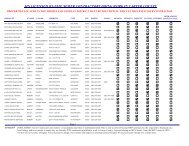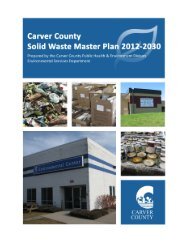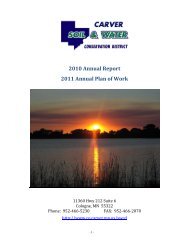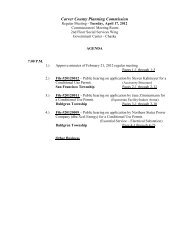Unintended Pregnancy - Carver County
Unintended Pregnancy - Carver County
Unintended Pregnancy - Carver County
You also want an ePaper? Increase the reach of your titles
YUMPU automatically turns print PDFs into web optimized ePapers that Google loves.
will not receive grant funding for family planning programs in<br />
2004 due to budget cuts at the state level. Therefore, CCCHS<br />
will be working with other community members to connect<br />
clients to other low-cost family planning resources.<br />
Minnesota’s family planning funds, including those received<br />
by <strong>Carver</strong> <strong>County</strong> Community Health Services, have never<br />
been used to counsel towards or provide abortion services.<br />
The CCCHS Family Planning Program and Maternal and Child<br />
Health Program have helped families:<br />
• Avoid unintended pregnancy and abortion<br />
• Take advantage of pre-pregnancy risk identification and<br />
management and initiate needed changes in diet,<br />
exercise, smoking, drinking and toxic exposure<br />
• Receive services such as counseling, screening and<br />
prevention programs that promote emotional, mental<br />
and physical health, as well as social responsibility<br />
• Time the additions to their families when their health,<br />
financial conditions and personal situation are optimal,<br />
and they are prepared to provide the support and care<br />
needed to all children to reach their full potential.<br />
Women Most At Risk for <strong>Unintended</strong> <strong>Pregnancy</strong><br />
Within the at-risk for unintended pregnancy population,<br />
women living in poverty and women of color have a history of<br />
being at a greater risk for unintended pregnancy and poor birth<br />
outcomes, according to a Minnesota Department of Health<br />
report. 9<br />
A report by Family Planning Perspectives found that 61<br />
percent of the pregnancies to women living below Federal<br />
Poverty Guidelines, and 53 percent of the pregnancies of<br />
women living between 100 and 199 percent of poverty, are<br />
unintended. 9 In <strong>Carver</strong> <strong>County</strong>, 3.5 percent of the population<br />
lives below 100 percent of poverty, and 12 percent lives below<br />
200 percent of poverty. 10<br />
The Alan Guttmacher Institute estimates that women living<br />
below 200 percent of poverty make up 20 percent of the total<br />
number of women at risk for unintended pregnancy. The<br />
Minnesota Department of Health has used the Alan Guttmacher<br />
Institute’s 1995 data to estimate there are 1,628 <strong>Carver</strong> <strong>County</strong><br />
women who are low income (living at below 200 percent of<br />
poverty) and at risk for unintended pregnancy. Included in this<br />
group are women who have no insurance or are under-insured<br />
in the sense that their insurance policies do not cover the cost<br />
of family planning exams and/or contraceptive services and<br />
supplies. 4<br />
Approximately 8.3 percent of women from <strong>Carver</strong> <strong>County</strong> who<br />
delivered babies in 2001 were women of color; 91.7 percent<br />
were white, non-Hispanic/Latino origin, and 4.8 percent were<br />
Hispanic. 10 <strong>Carver</strong> <strong>County</strong> Community Health Services<br />
(CCCHS) is aware of the increasingly diverse county<br />
population and the need to provide services that are culturally<br />
and linguistically appropriate for those populations. In 2001, 22<br />
percent of the women who received family planning services<br />
from CCCHS were non-white and 19 percent were Hispanic. 11<br />
The Family Planning Perspectives 1998 report also found that<br />
72 percent of pregnancies to African Americans and 48 percent<br />
of pregnancies to Hispanics were unintended. 9<br />
CCCHS has focused its efforts on providing pre-pregnancy<br />
family planning services on the populations most at risk for<br />
unintended pregnancies. In 2002, county public health nurses<br />
provided home visits through the Maternal Child Health Grant<br />
CARVER COUNTY COMMUNITY HEALTH SERVICES/PUBLIC HEALTH -109- 2004-2008 ASSESSMENT
















